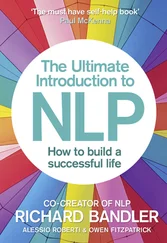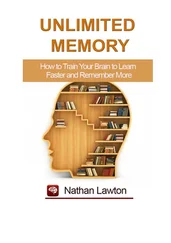Using Your Brain —for a CHANGE
Dedicated to my mother
How often have you heard the phrase, "She has a bright future" or, "He has a colorful past"? Expressions like these are more than metaphors. They are precise descriptions of the speaker's internal thinking, and these descriptions are the key to learning how to change your own experience in useful ways. For instance, right now notice how you picture a pleasant future event in your own life . . . and then brighten that picture and notice how your feelings change. When you brighten that picture, do you "look forward" to it more? Most people respond more strongly to a brighter picture; a few respond more to a dimmer picture.
Now take a pleasant memory from your past and literally make the colors stronger and more intense. . . . How does having a "colorful past" change the intensity of your response to that memory? If you don't notice a difference in your feelings when you make your memory more colorful, try seeing that memory in black and white. As the image loses its color, typically your response will be weaker.
Another common expression is, "Add a little sparkle to your life." Think of another pleasant experience, and literally sprinkle your image of it with little shining points of sparkling light, and notice how that affects your feeling response. (Television advertisers and designers of sequined clothing know about this one!)
"Put your past behind you," is common advice for unpleasant events. Think of a memory that still makes you feel bad, and then notice where you see it now, and how far away the picture is. Probably it's fairly close in front of you. Now take that picture and physically move it far behind you. How does that change how you experience that memory?
These are a few very basic examples of the simplicity and power of the new NLP "Submodalities" patterns developed by Richard Bandler in the last few years. One of the earliest NLP patterns was the idea of "Modalities" or "Representational Systems." We think about any experience using sensory system representations—visual pictures, auditory sounds and kinesthetic feelings. Most NLP Training during the last ten years has taught a wide variety of rapid and practical ways to use this knowledge of modalities to change feelings and behavior. Submodalities are the smaller elements within each modality. For example, a few of the visual submodalities are brightness, color, size, distance, location, and focus. Knowledge of Submodalities opens up a whole new realm of change patterns that are even faster, easier, and more specific.
When we were first introduced to NLP in the fall of 1977, we set aside most of what we were doing in order to study these exciting and rapid new ways of changing behavior. At that time Richard Bandler and John Grinder were collaborating on the development of this new field, which promised a great deal. NLP taught how to follow a person's internal process by paying attention to unconscious eye movements, how to change old unpleasant feeling responses in minutes, and much more.
Now, seven years later, all those promises and many more have been kept. All the basic ideas and techniques of NLP have withstood the test of time, as well as the tougher test of teaching others how to make practical use of them. NLP has often been described as the field on the cutting edge of communication and change.
NLP offers a conceptual understanding that is solidly based on information science and computer programming, yet rooted even more thoroughly in the observation of living human experience. Everything in NLP can be directly verified in your own experience, or by observing others.
The new submodality patterns described and taught in this book are even faster and more powerful ways of creating personal change than the earlier NLP methods. There are only three major modalities, but there are many submodalities within each modality. Submodalities are literally the ways that our brains sort and code our experience. The submodality change patterns can be used to directly change the human software — the ways we think about and respond to our experiences.
Some critics have contended that NLP is too "cold" and "technical," and that while it may be successful with simple habits and phobias, it doesn't deal with "core existential issues." We will be interested in these critics' responses to the methods for changing understandings and beliefs demonstrated in chapters 6 and 7.
This book opens a doorway to a practical new way of understanding how your mind works. More important, this book teaches specific simple principles that you can use to "run your own brain." It teaches you how to change your own experience when you're not pleased with it, and to further enhance your enjoyment when your life is going well.
Many of us have the ability to take known principles and make useful adaptations of those principles, or make a small innovation now and then. Richard Bandler's special genius is his unparalleled ability to repeatedly delineate new principles, and to make them available to the rest of us. His sense of humor may sometimes sound caustic and arrogant, particularly when it is directed toward the professions of psychology and psychiatry (although other "experts" get their share!). This is at least partly understandable when you realize that although the NLP 10–minute phobia/trauma cure was first published over six years ago, most psychologists continue to believe that it takes months or years of talking and drugs (and several thousand dollars) to cure a phobia. We know well the frustration of being told, "It can't be done," when we have demonstrated it hundreds of times, and taught many others to do it consistently.
When a major technical innovation occurs in any industry, manufacturers around the world are eager to make immediate use of the new method, because they know that if they don't, competitors will put them out of business. Unfortunately, there is much more inertia in fields like psychology, in which professionals get paid more if they take longer to solve a problem. Since incompetence is rewarded, new and better methods take much longer to become part of the mainstream in these fields.
This inertia in the field of psychology has also been lamented by many others. Salvador Minuchin, well–known innovator in the field of family therapy, recently said:
"How did people respond to our (research) findings? By defending their own paradigms. In response to new knowledge, there is always the question of how to maintain oneself doing the things one was trained in."
Despite this inertia, there are many exceptions within the fields of psychology and psychiatry — professionals who are eager to learn about any methods that can benefit their clients by making their work faster, better, and more thorough. We hope this book finds its way into your hands.
Several years ago we became aware of the new direction that Richard Bandler's genius was exploring, and we realized how useful these new patterns could be for people everywhere if they were more widely known. However, it is primarily our own personal fascination and excitement with submodalities that has led us to create this book.
Our raw materials were audiotapes and transcripts of a large number of seminars and workshops that Richard has taught recently. Then came a long process of sorting through and organizing this wealth of material, experimenting with it personally, and teaching it to others in order to gain a richer understanding. Finally, based on what we had learned, we have put this material together in the form of this book. We have tried to preserve the living style and flavor of the original seminars, while at the same time reorganizing and sequencing the material to make it easier to understand in written form.
Читать дальше




![Джон Харгрейв - Mind Hacking [How to Change Your Mind for Good in 21 Days]](/books/404192/dzhon-hargrejv-mind-hacking-how-to-change-your-min-thumb.webp)






